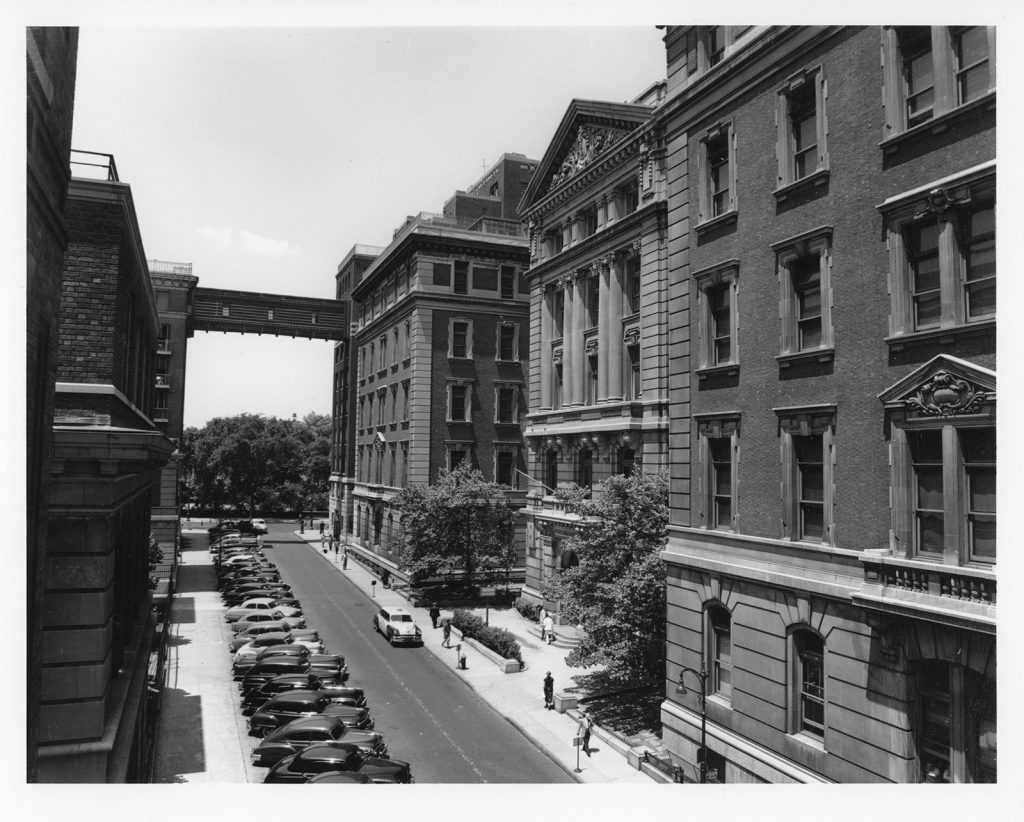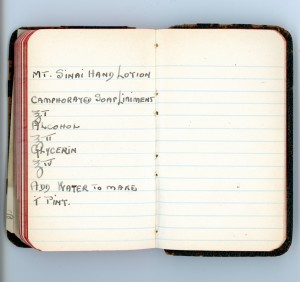NINA D. GAGE, ROOSEVELT HOSPITAL SCHOOL OF NURSING ALUMNA and NURSING IN CHINA
One of the collections held by the Arthur H. Aufses, Jr. MD Archives is the Roosevelt Hospital School of Nursing records (1896-1974). A gift to the collection is a scrapbook from alumna Evelyn I.V. Howard, class of 1908, who captured images of her fellow classmates and house staff physicians during her years in training there. Included among her friends were images of Nina Gage, who went on to join a missionary outreach in Changsha, Hunan Province in China in 1909. Gage worked in the hospital created by the team, and established a nursing school for both men and women. The scrapbook includes images of the hospital founded by the team as well as the nursing school students’ classes and hospital scenes sent to Howard by Gage. They illustrate an important time in the development of China’s medical history.
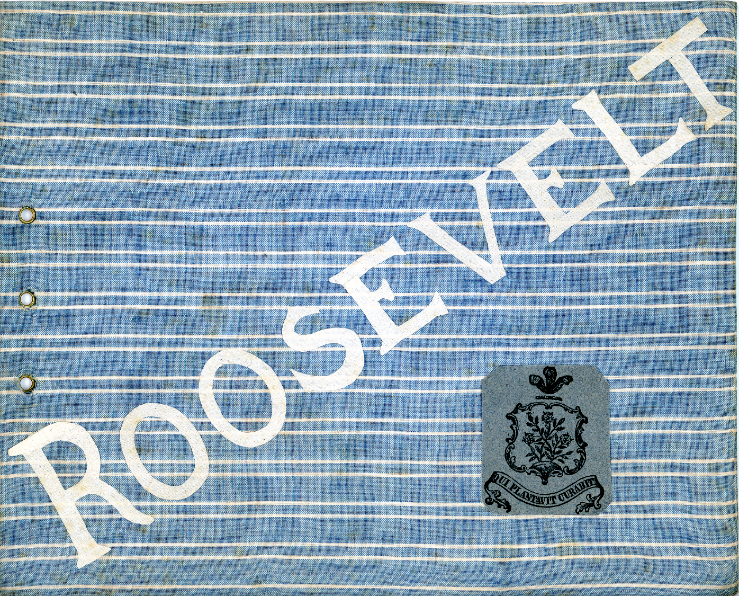
NURSING IN CHINA
Nursing, as a profession, was almost unheard of in pre-20th century China. Traditional Chinese healers diagnosed patients by observing various parts of the body – the tongue, the pulse (taken in both arms), and asking extensive questions. They then prescribed herbal remedies, massage, acupuncture or other methods to balance yin and yang – the two great opposing and complimentary forces in nature – to bring the body back into balance. (Forgive the simplification; this is a very basic explanation of Chinese medicine.) The family themselves, or their servants, in wealthy households, treated the patient at home – hospitals were also introduced by western missionaries – following the prescribed treatment. It is significant to note that most of the care givers were men.

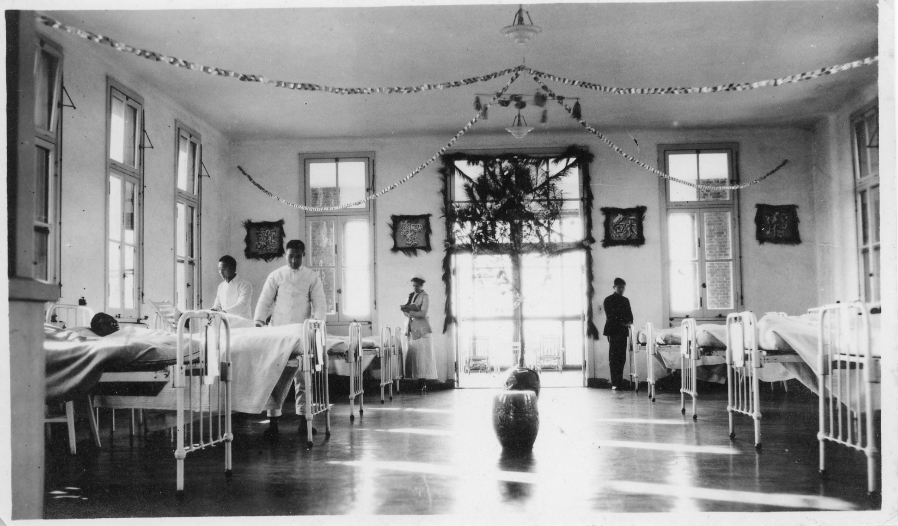
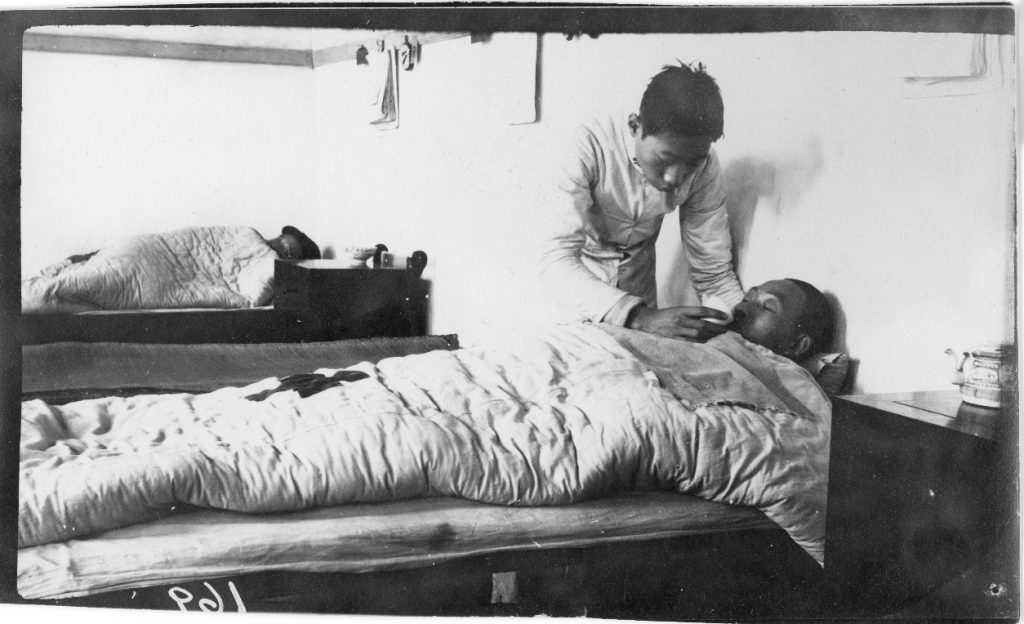
THE YALE-IN-CHINA MISSION
Starting in the 1880s, western missionaries brought modern medical methods to various large cities of China where they established missions’ projects. One team, organized by Yale University’s Christian Missions Society, was the Yale-in-China mission. The team consisted of members of the Yale class of 1898 and their families. Additionally, Nina Gage, a 1908 graduate of the Roosevelt Hospital School of Nursing, and sister to team-member Brownall Gage, joined them in 1909 to work as a nurse in the hospital/clinic and to help establish a modern nursing program.
One of the team members, working with experienced missionaries from a northern project, arrived in 1902 to visit possible cities to establish the work. He then reported back to the Yale Missions Society board and the project team about the cities he visited for their consideration. Eventually they chose the city of Changsha, Hunan Province in southern China to establish the Yale-in-China Mission. Selected for its large size, Changsha was considered extremely clean and well built, according to the more experienced missionaries. Changsha’s alleys were paved with granite and it had a good sewage system, compared to other cities. Other missionaries had high opinions of the people there, citing them as born leaders who were very independent and influential in Chinese culture and life.

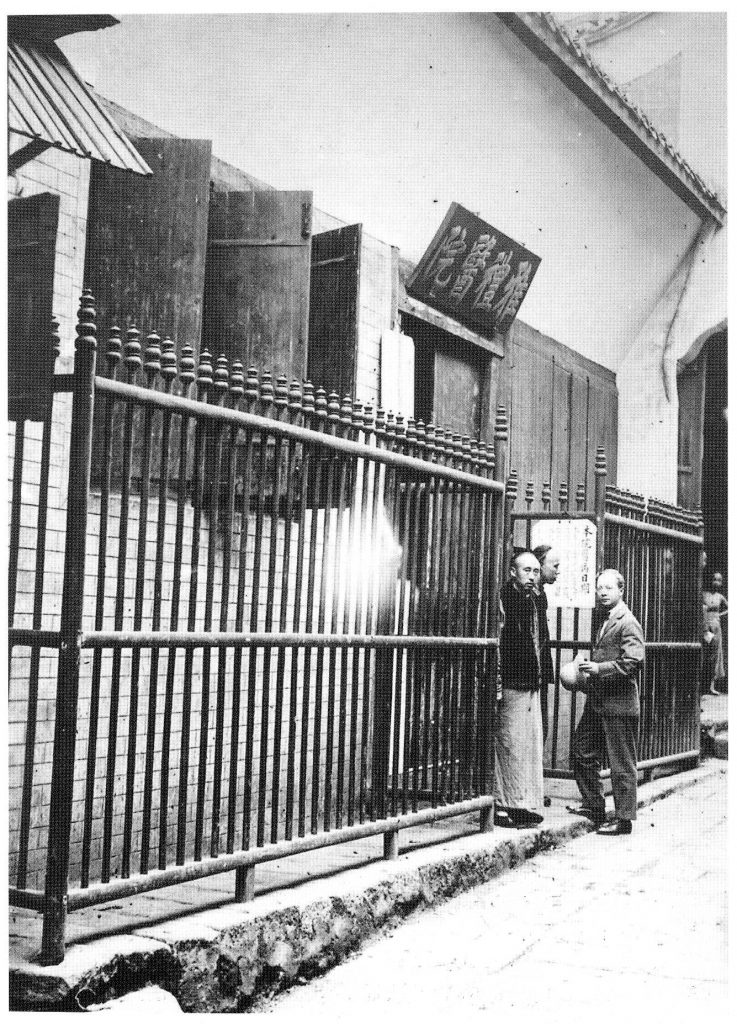
In 1904, the team rented two buildings near the center of the city that were large enough to support their plans to establish a prep school and college, a medical school and hospital/clinic, as well as a nurse training school. One building was large enough to carve out several classrooms and dormitory space for students and housing for the team, while the other building served as a hospital/clinic.
Left: The Yale Mission’s early medical work was led by Edward Hume, M.D., Yale class of 1897. Hume (right) is pictured with two Chinese colleagues at the door of the mission’s first clinic and hospital, housed in a converted inn in the crowded center of Changsha.

NINA D. GAGE
Nina Diadamia Gage was born in 1883 in Brooklyn, and she and her siblings grew up in and around New York City. She attended Wellesley College, where, like her older brother, she was an active member of the missionary committee. After graduating, Gage entered Roosevelt Hospital’s Training School for Nursing, which had opened in 1896. (Roosevelt Hospital was renamed Mount Sinai West in 2015.)

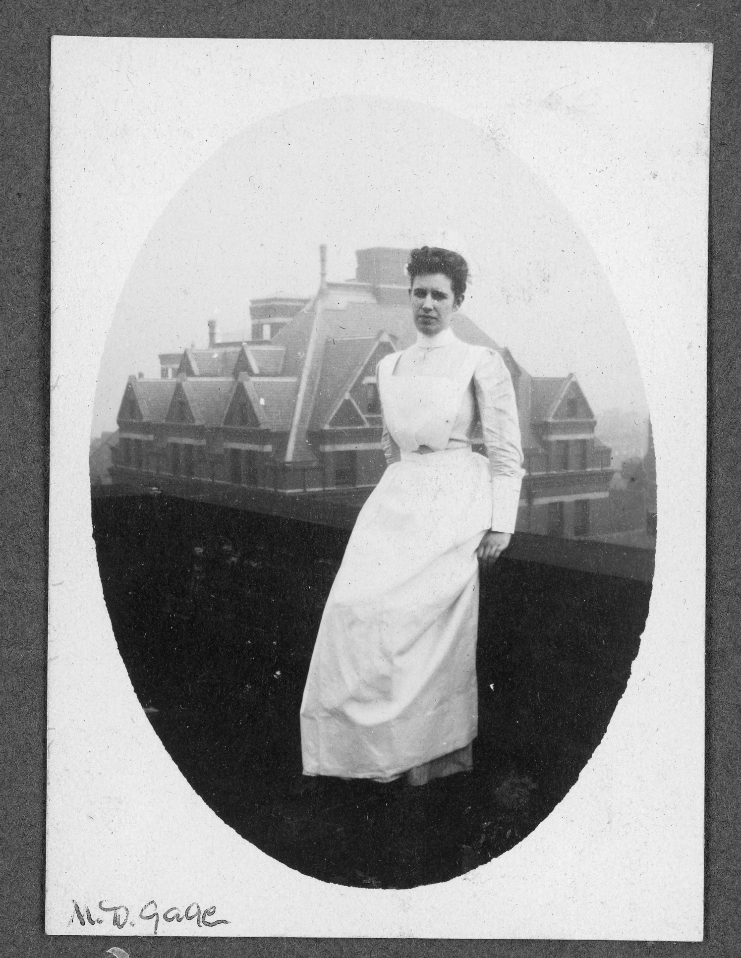
Nina Gage as a student nurse, relaxing on a building rooftop, at Roosevelt Hospital’s School of Nursing, circa 1907
At that time, student nurses were trained at the bedside by the senior student nurses, as graduate professional nurses were few in those years. The junior nurses, who served as floor staff, were taught to take vitals, change bandages, feed and clean patients, note changes in the patient’s condition to report to the attending physician during rounds, and keep the ward itself clean. Weekly lectures by the staff physicians supplemented and expanded the bedside training. Monthly lectures considered a different area of medical care. One would assume these lessons were repeated by Gage to her Chinese students.
This page describes part of a year’s weekly lectures for the nursing student at Roosevelt Hospital’s School of Nursing. Taken from Fifty Years of Service: History of the School of Nursing of the Roosevelt Hospital, New York City, 1896-1946 by Evelyn G. Fraser.
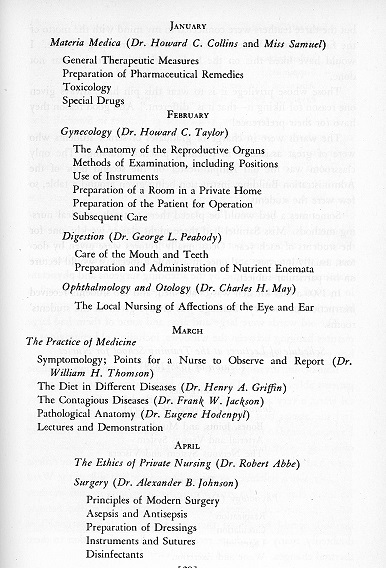
After graduating in 1908, Gage was employed as a night nurse while making the necessary arrangements to move to Changsha in 1909 to join her brother and the Yale team. She thought it was important to learn the language, and took that first year to study it while she worked in the “Yali Hospital” (as it was called) clinic and assisted the doctors in surgery and planning the establishment of the nursing school, which opened in 1913.
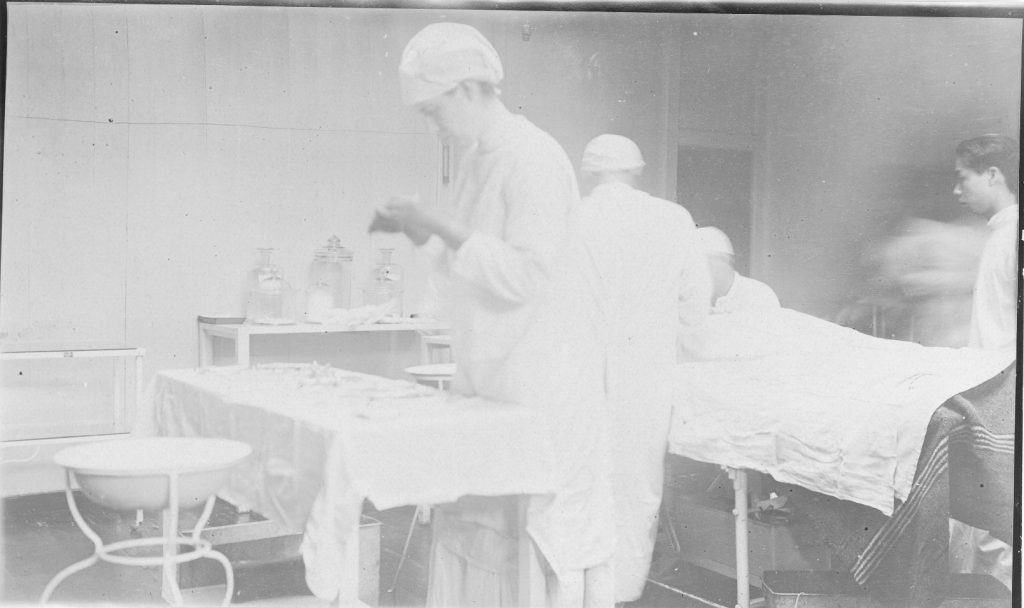
THE HSIANG-YA NURSING SCHOOL
Since nursing as a profession was new in China, Gage had the interesting – and daunting – privilege to create the Chinese name for it. She selected “Scholars to Watch and Guard” or more briefly, “Guard Scholars” – to indicate nurses.
Advertising posters were hung around the city to announce the opening of the school, inviting “both boys and girls to be admitted for training in a new profession” (Hume, E., p. 168). The entrance requirements for the “Scholars to Watch and Guard” training were two years of middle school and passing the school’s entrance examinations in Chinese and arithmetic. Parental consent and the payment of school fees were also required. On examination day, twenty girls and forty boys arrived to take the tests. A few applicants backed out, intimidated by the exam questions, but in the end, five girls and seven boys became the first class of trainees.

Female students, in particular, had problems gaining entrance, as at that time, girls were prepared from a young age for marriage and lived very secluded lives, neither meeting nor socializing with boys outside of immediate family. However, once they demonstrated success in passing the entrance exams, doubtful parents were content to allow them to continue and in the end were very proud to have graduate ‘Guard Scholar’ daughters in crisp white uniforms, ready to serve their communities in such a positive way.
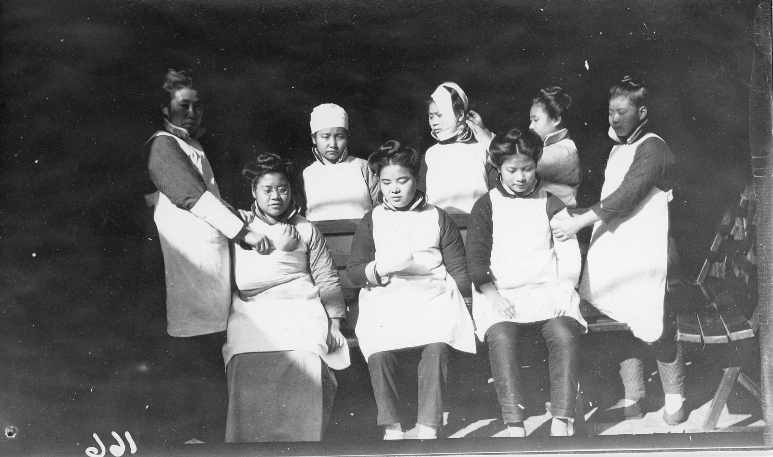

Initially the nursing school and hospital were simply called the Yali School, but in the early teens, both were renamed “Hsiang-Ya” – “Hsiang” indicating “Hunan” and “Ya” indicating “Yale,” highlighting the partnership of Hunanese teachers and students with the Yale teachers and administrators.
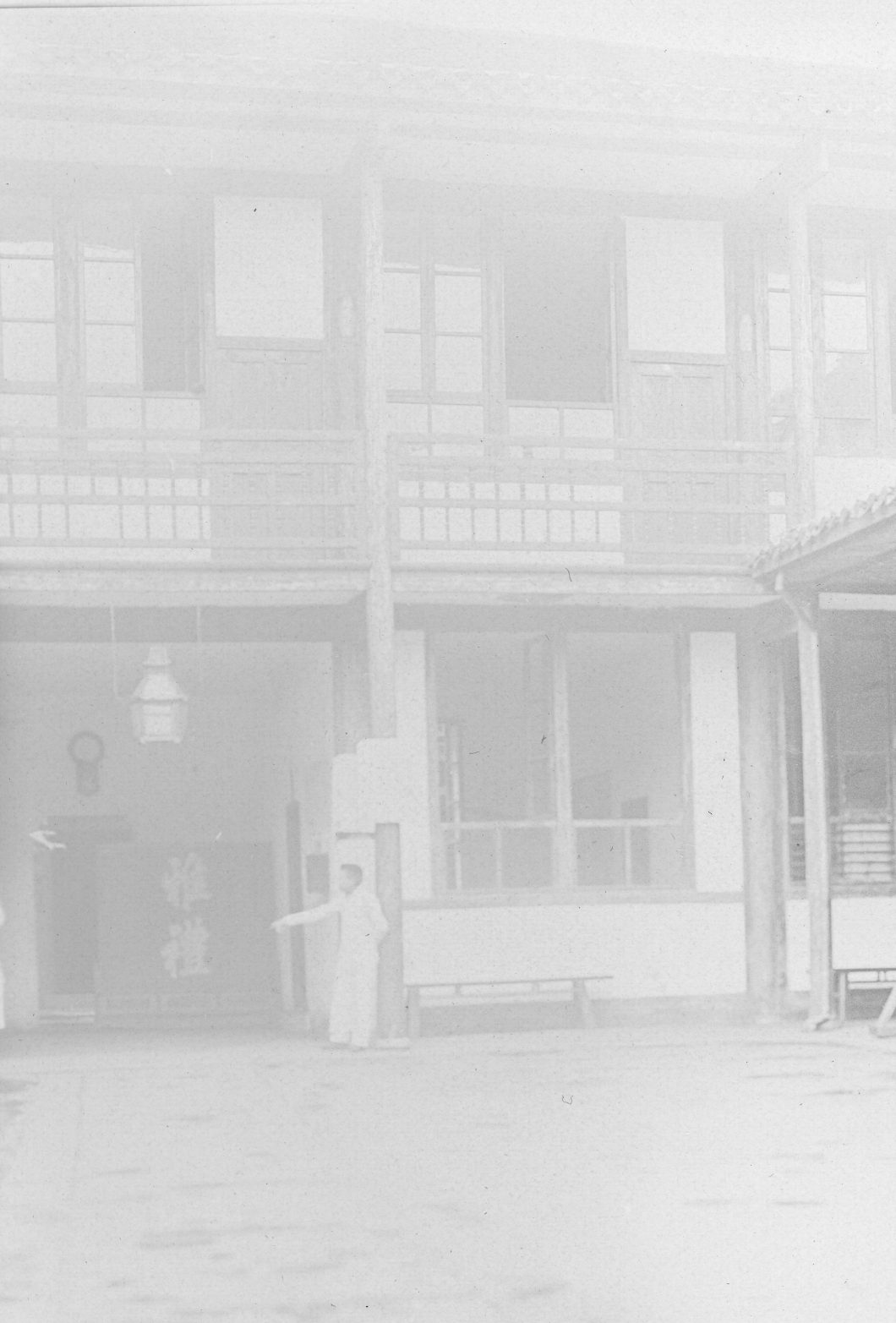
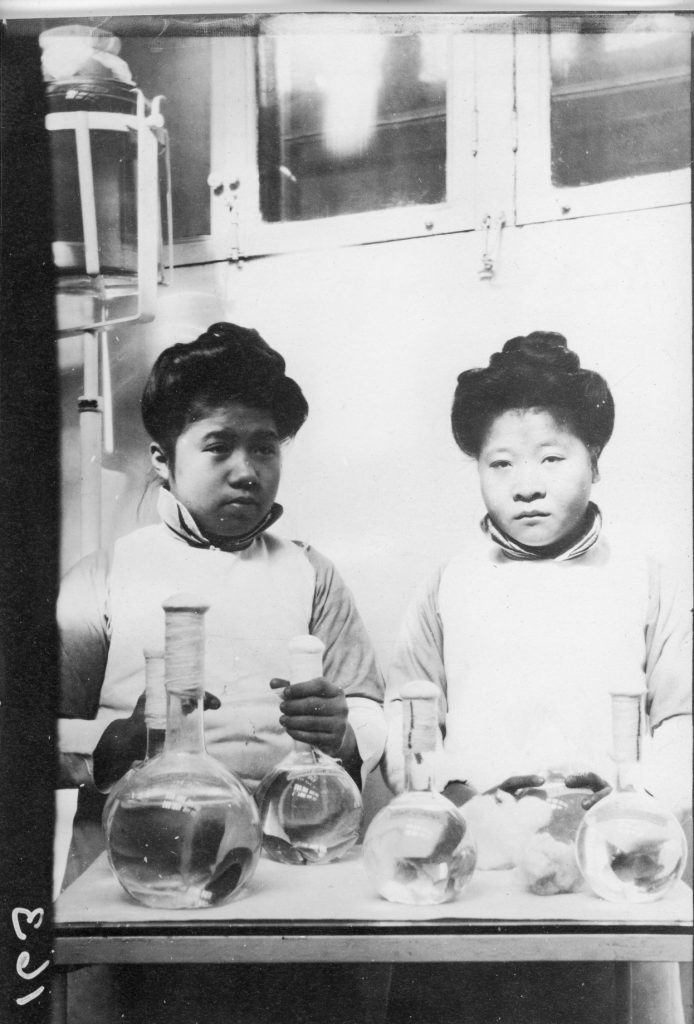

In 1927, due to the on-going political turmoil, all foreigners were expelled from China, the Yale-in-China Mission closed, and the team returned to the United States. By 1929, however, the Yale-in-China work resumed, but under Chinese leadership and direction. The hospital and schools of the Yale Mission continue to exist to this day, though they have been absorbed into larger university settings. The relationship between Yale University and China also continues to this day as Yale-China (雅礼协会), based in New Haven, CT, which “bridges the United States and China through collaborative partnerships in education, healthcare, and the arts” (The Yale-China mission statement, from their webpage).

Gage is among the handful of notable women who brought modern professional nursing to China. In additional to teaching and working in the hospital, Gage helped found the Nurses’ Association of China (NAC) in 1909, signifying the start of a professional nursing movement in the country. The founding members were mostly western missionary nurses who came together to organize, but they were soon joined by Chinese colleagues. By 1915, China established an examination system for the professional certification of nurses, followed by other advances to promote nursing education across the Asian continent.
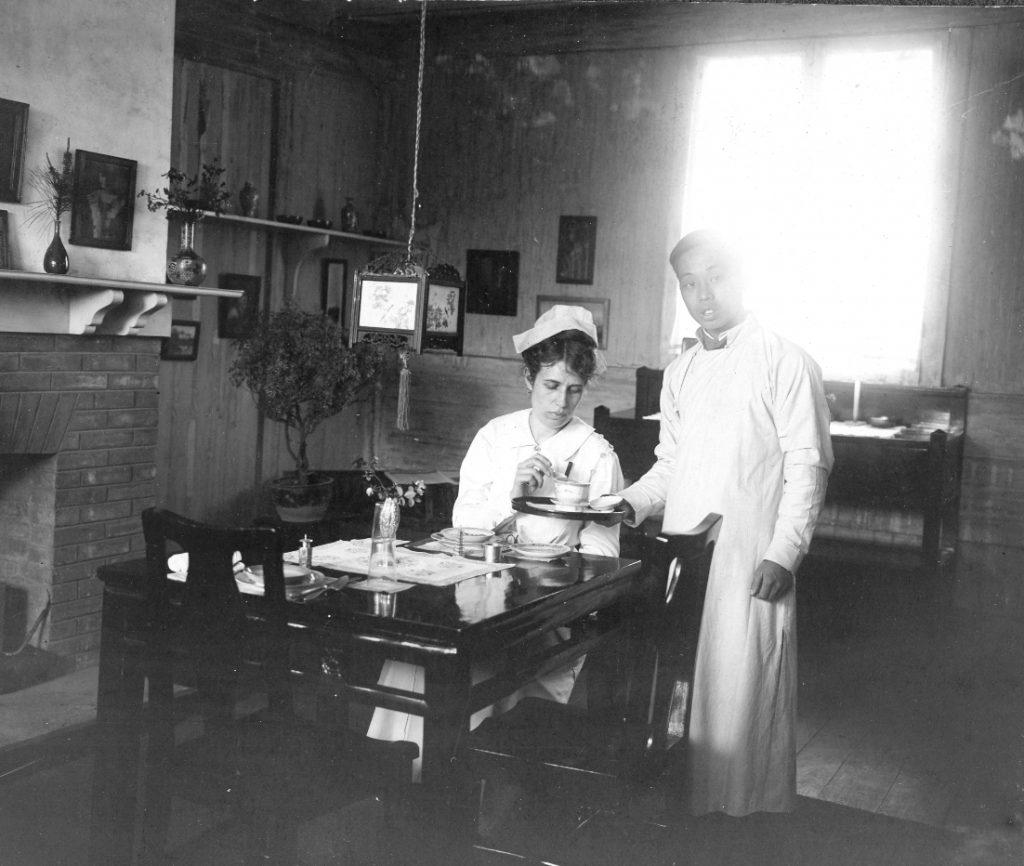
In 1912, Gage was elected as the first president of the NAC, serving a two-year term. She went on to serve as the chairperson of its education committee. After a brief return to the U.S. during WWI, where she taught wartime nursing at Vassar, Gage returned to Chine and was appointed Dean of the Hsiang-Ya Nursing School, as it was renamed.
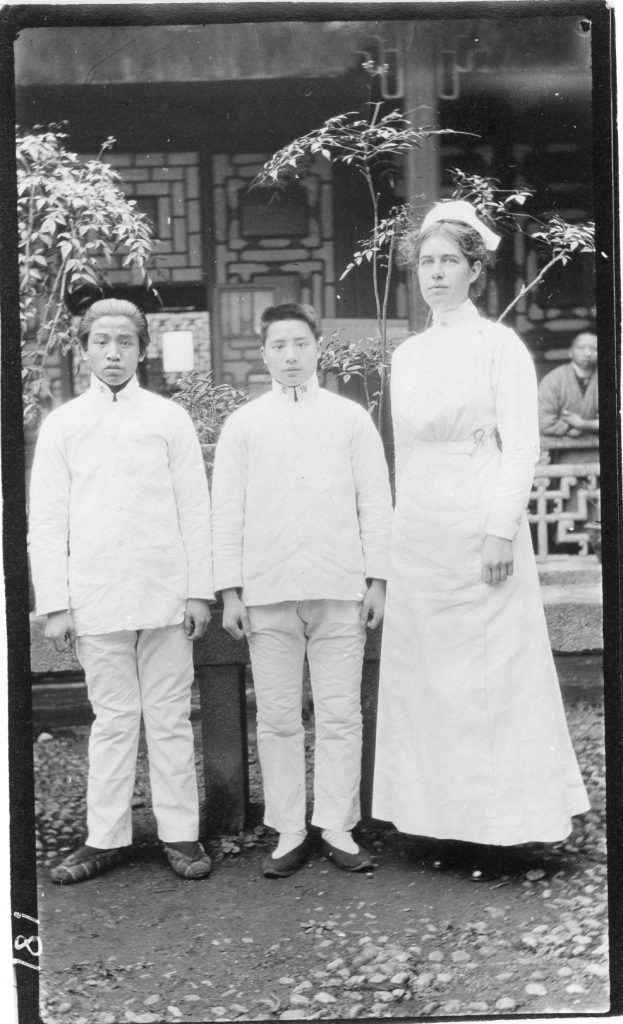
GAGE’S POST-CHINA LIFE
Upon returning to the United States in 1927, Nina Gage continued to work in nursing and was active in its support organizations. From 1925 to 1929, she served as president of the International Council of Nurses, representing China. She was executive secretary of the National League for Nursing Education from 1928 to 1931. In 1930, during her term as president of the Roosevelt Hospital School of Nursing Alumnae Association, she started The Roosevelt Hospital School of Nursing Alumnae Association Bulletin, later renamed The Roosevelt Review, which published news about alumnae activities but also included articles on developments in nursing practice and medicine in general. Throughout her working years, Gage remained active in the National Nursing Association and the American Nurses Association. Gage also published several articles on nursing in China for The American Journal of Nursing and as well as authoring two books: A General History of Nursing in 1933 and Communicable Diseases in 1940.
In the U.S. Gage continued working as a teacher to the next generation of professionals. In 1927 she became educational director and director of the nursing department of the Willard Parker Hospital in NYC. In 1931, the historically Black Hampton Institute (Hampton, VA) appointed Gage as director of its new nursing school. She taught at the Jersey City Medical Center Nursing School during the 1934-1935 school year and then went to the Newport Hospital (Newport, R.I.) as director of its school of nursing from 1935 to 1943. In 1949, Newport Hospital’s Gage Hall was named in her honor. From 1943 until her retirement in 1945, she was the Director of Nursing at the Protestant Hospital in Nashville, Tennessee. She died on October 18, 1946, at the age of 63.
Right: An older Nina Gage, undated

Authored by Michala Biondi, Associate Archivist
Sources
Burst, Helen Varney. “Yale School of Nursing: celebrating 90 years of excellence.” Yale University EliScholar, 2013. https://core.ac.uk/download/232765997.pdf
Chapman, Nancy; J. Plumb. The Yale-China Association: A Centennial History. Hong Kong: The Chinese University Press, 2001.
Clark, Alice. “The Nurses’ Association of China.” The American Journal of Nursing, Vol. 15, No. 1 (Oct., 1914), pp. 42-46 (5 pages).
Gage, Nina D. “Nursing in China,” The American Journal of Nursing, Vol. 18, No. 9 (Jun., 1918), pp. 797-800.
Hume, Edward H., M.D. Doctors East Doctors West: An American Physician’s Life in China. New York: W. W. Norton & Company, Inc., 1946.
Hume, Lotta Carswell. Drama at the doctor’s gate; the story of Doctor Edward Hume of Yale-in-China. New Haven: Yale-in-China Association, 1961.
Levitan, Kathi. “Nina D. Gage: An American Nurse in Early Twentieth Century China.” Master’s Thesis, Yale University School of Nursing, 2000 Dec.
“Nina D. Gage, R.N.”, The American Journal of Nursing, Jan 1926, 26:1, pg. 8. https://www.jstor.org/stable/3408648
Smith, Derek R. Nursing in China: Historical development, current issues and future challenges. Oita Journal of Nursing Science 5(2), (2004), 16- 20.
Wikipedia entry: Nina Gage. https://en.wikipedia.org/wiki/Nina_Gage
WikiLectures – Nursing in Ancient China. https://www.wikilectures.eu/w/Nursing_in_Ancient_China
Yuhong, Jiang. “Shaping modern nursing development in China before 1949.” International Journal of Nursing Science. 2016 Dec 29; 4 (1): 19-23. https://pubmed.ncbi.nlm.nih.gov/31406712/
To read a profile of another Roosevelt Hospital School of Nursing alumna, see our post on Elise Galloway, class of 1906.

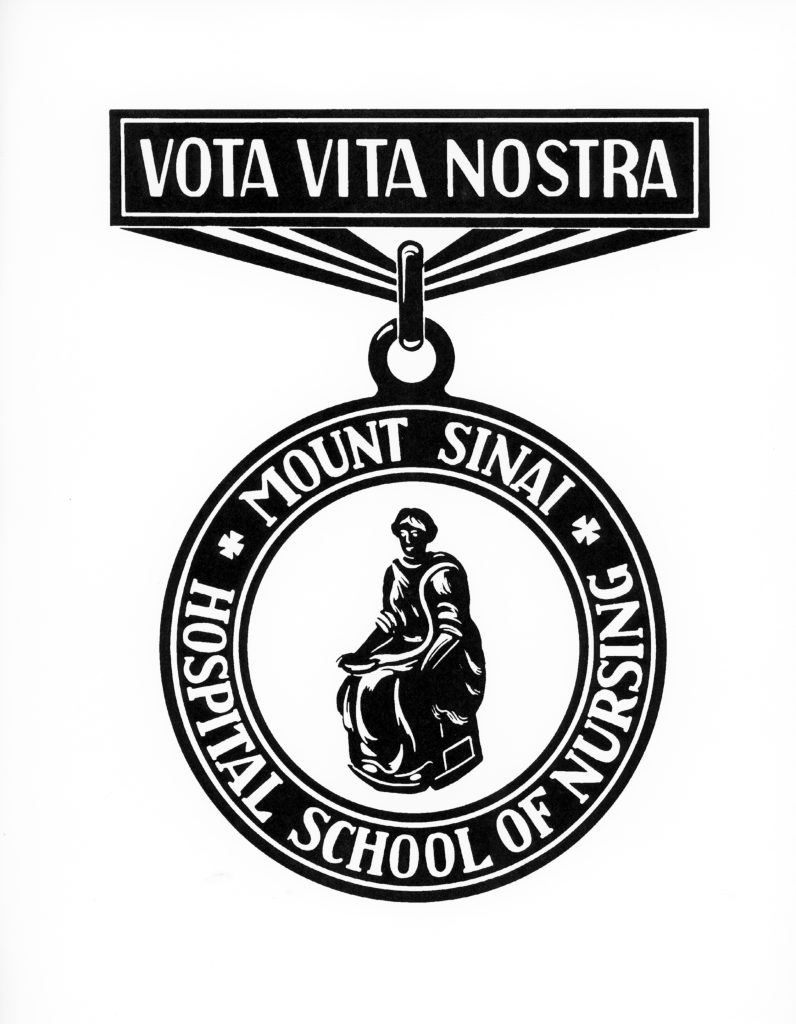 male student in the last class. (A complete history of the School is available
male student in the last class. (A complete history of the School is available  And so it was, but only briefly. The first class was admitted to the program in fall 1969, along with a sophomore group that had started at Sinai, and a graduation ceremony was held in 1972 for thirteen students. However, the two institutions could not work out long-term arrangements and so the relationship was terminated by 1974.
And so it was, but only briefly. The first class was admitted to the program in fall 1969, along with a sophomore group that had started at Sinai, and a graduation ceremony was held in 1972 for thirteen students. However, the two institutions could not work out long-term arrangements and so the relationship was terminated by 1974.